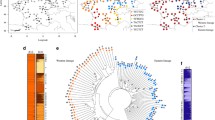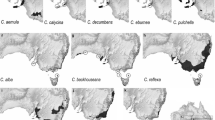Abstract
A structured collection of 80 seedling pecan trees [Carya illinoinensis (Wangenh.) K. Koch], representing 19 putatively native pecan populations across the species range, was evaluated at three plastid and 14 nuclear microsatellite (simple sequence repeat, SSR) loci. Data were analyzed using a priori population designations and also within a Bayesian framework, in which individuals were assigned to clusters regardless of population of origin. Population genetic analyses using a priori populations, clusters based on chloroplast microsatellite data (cpSSR), and clusters based on nuclear microsatellite data (nSSR) yielded consistent results. For all groupings, cpSSR variation exhibited more geographic structure than the nSSR data. Furthermore, cpSSR microsatellite diversity decreased with increasing latitude, but this pattern was not observed with the nuclear data. Contrasting patterns in plastid and nuclear genetic diversity demonstrate unique aspects of postglacial recolonization reflected in the movement of seeds versus pollen. These data suggest that plastid SSRs are useful tools for identifying population structure in pecan and hold promise for ongoing efforts to identify and conserve representative germplasm in ex situ collections.




Similar content being viewed by others
References
Abrams MD, Nowacki GJ (2008) Native Americans as active and passive promoters of mast and fruit trees in the eastern USA. Holocene 18:1123–1137
Acosta MC, Premoli AC (2010) Evidence of chloroplast capture in South American Nothofagus (subgenus Nothofagus, Nothofagaceae). Mol Phylogenet Evol 54:235–242
Amos W, Hoffman JI, Frodsham A, Zhang L, Best S, Hill AVS (2007) Automated binning of microsatellite alleles: problems and solutions. Mol Ecol Notes 7:10–14
Braun EL (1961) Woody plants of Ohio. Ohio State University Press, Columbus, p 362
Bryan GJ, McNicol J, Ramsay G, Meyer RC, Jong WSD (1999) Polymorphic simple sequence repeat markers in chloroplast genomes of Solanaceous plants. Theor Appl Genet 99:859–867
Caicedo AL, Stinchcombe JR, Olsen KM, Schmitt J, Purugganan MD (2004) Epistatic interaction between Arabidopsis FRI and FLC flowering time genes generates a latitudinal cline in a life history trait. Proc Nat Acad Sci USA 101:15670–15675
Charlesworth B, Charlesworth D, Barton NH (2003) The effects of genetic and geographic structure on neutral variation. Ann Rev Ecol Evol Systemat 34:99–125
Cheng YJ, Meng HJ, Guo WW, Deng XX (2006) Universal chloroplast primer pairs for simple sequence repeat analysis in diverse genera of fruit crops. The Journal of Horticultural Science and Biotechnology 81:132–138
Dangl GS, Woeste K, Aradhya MK, Koehmstedt A, Simon C, Potter D, Leslie C, McGranahan GH (2005) Characterization of 14 microsatellite markers for genetic analysis and cultivar identification of walnut. The Journal of Horticultural Science and Biotechnology 130:348–354
Delcourt PA, Delcourt HR (1987) Long-term forest dynamics of the temperate zone: a case study of late-quaternary forests in Eastern North America. Springer, New York
Dering JP (1977) Baker Cave plant macrofossil report. Unpublished manuscript on file with the Baker Cave Project Texas Archeological Research Laboratory, University of Texas at Austin
Ennos RA (1994) Estimating the relative rates of pollen and seed migration among plant populations. Heredity 72:250–259
Fagan BM (1992) People of the earth: an introduction to world prehistory. Harper Collins Publishers, New York
Flores D, Ford M (2009) Mexico tree nuts annual 2009. USDA FAS Global Agricultural Information Network (GAIN) Report Number MX9061
Graham A (1999) The Tertiary history of the northern temperate element in the northern Latin American biota. Am J Bot 86:32–38
Grauke LJ, Payne JA, Wood BW (1989) North American pecans: a provenance study. Annual Report of the Northern Nut Growers Association 80:124–131
Grauke LJ, Iqbal MJ, Reddy AS, Thompson TE (2003) Development of microsatellite DNA markers in pecan. Journal of the American Society for Horticultural Science 128(3):374–380
Harlan JR (1992) Crops and man. American Society of Agronomy, Inc., Crop Science Society of America, Inc. Madison, Wisconsin
Harper RM (1928) Economic botany of Alabama. Part 2. Catalogue of the trees, shrubs and vines of Alabama, with their economic properties and local distribution. Geological survey of Alabama. University of Alabama
Hester TR (1981) Late Paleo Indian occupations at Baker Cave, southwestern Texas. Bull Tex Arch Soc 53(101):119
Hewitt GM (1996) Some genetic consequences of ice ages, and their role in divergence and speciation. Biol J Linn Soc 58:247–276
Hiraoka K, Tomaru N (2009) Population genetic structure of Fagus japonica revealed by nuclear microsatellite markers. Int J Plant Sci 170:748-758
Hu XS, Ennos RA (1999) Impacts of seed and pollen flow on population differentiation for plant genomes with three contrasting modes of inheritance. Genetics 152:441–450
Jump AS, Marchant R, Peñuelas J (2009) Environmental change and the option value of genetic diversity. Trends Plant Sci 14:51–58
Latta RG (2006) Integrating patterns across multiple genetic markers to infer spatial processes. Landscape Ecol 21:809–820
Magri D, Vendramin GG, Comps B, Dupanloup I, Geburek T, Gömöry D, Latalowa M, Litt T, Paule L, Roure JM, Tantau I, van der Knaap WO, Petit R, de Beauliu J-L (2006) A new scenario of the quaternary history of European beech populations: palaebotanical evidence and genetic consequences. New Phytol 71:199–221
Manchester SR (1999) Biogeographical relationships of North American Tertiarty floras. Ann Mo Bot Gard 86:472–522
Manning WE (1949) The genus Carya in Mexico. J Arn Arb 30:425–432
Manning WE (1962) Additional notes on Juglans and Carya in Mexico and Central America. Bul Torrey Bot Soc 89(2):110–113
Meloni M, Perini D, Binelli G (2007) The distribution of genetic variation in Norway spruce (Picea abies Karst.) populations in the western Alps. J Biogeogr 34:929–938
Mendoza-Herrera, MA, Grauke LJ, Binzel M (2008) Confirmation of SSR markers within a structured collection of pecan [Carya illinoinensis (Wangenh.) K. Koch], cultivars. Plant and Animal Genome XVI Conf.. San Diego, CA. Jan. 12–16, 2008 (Abstract P140).
Milne RI (2006) Northern hemisphere plant disjunctions: a window on tertiary land bridges and climate change? Ann Bot 98:465–472
Miranda F, Sharp AJ (1950) Characteristics of the vegetation in certain temperate regions of eastern Mexico. Ecology 31:313–333
Mitchell-Olds T, Willis JH, Goldstein DB (2007) Which evolutionary processes influence natural genetic variation for phenotypic traits? Nat Rev Genet 8:845–856
Namkoong G, Gregorius HR (1985) Conditions for protected polymorphisms in subdivided plant populations. 2: seed versus pollen migration. Am Nat 125:521–534
Namkoong G, Lewontin RC, Yanchuk AD (2004) Plant genetic resource management: the next investments in quantitative and qualitative genetics. Genet Resour Crop Evol 51:853–862
Paterson AH, Brubaker C, Wendel JF (1993) A rapid method for extraction of cotton (Gossypium spp.) genomic DNA suitable for RFLP or PCR analysis. Plant Mol Biol Rep 11:122–127
Peakall R, Smouse PE (2006) GENALEX 6: genetic analysis in excel population genetic software for teaching and research. Mol Ecol Notes 6:288–295
Perrier X, Jacquemoud-Collet JP (2006) DARwin software. http://darwin.cirad.fr/darwin
Petit RJ, Bodenes C, Ducousso A, Roussel G, Kremer A (2003) Hybridization as a mechanism of invasion in oaks. New Phytologist 161:151–164
Pritchard JK, Wen X, Falush D (2007) Documentation for structure software: Version 2.2. http://pritch.bsd.uchicago.edu/software.
Rüter B, Hamrick JL, Wood BW (1999) Genetic diversity within provenance and cultivar germplasm collections versus natural populations of pecan (Carya illinoinensis). J Hered 90:521–528
Rüter B, Hamrick JL, Wood BW (2000) Outcrossing rates and relatedness estimates in pecan (Carya illinoinensis) populations. J Hered 91:72–75
Saitou N, Nei M (1987) The neighbor-joining method: a new method for reconstructing phylogenetic trees. Mol Biol Evol 4:406–425
Sloan DB, Barr CM, Olson MS, Keller SR, Taylor DR (2008) Evolutionary rate variation at multiple levels of biological organization in plant mitochondrial DNA. Mol Biol Evol 25:243–246
Smith BD (1992) Rivers of change: essays on early agriculture in eastern North America. Smithsonian Institute Press, Washington, DC
Soltis DE, Morris AB, McLachlan JS, Manos PS, Soltis PS (2006) Comparative phylogeography of unglaciated eastern North America. Mol Ecol 15:4261–4293
Stone DE (1962) Affinities of a Mexican endemic, Carya palmeri, with American and Asian hickories. Am J Bot 49:199–212
Styles BW, Ahler SR, Fowler ML (1983) Modoc rock shelter revisited. In: Phillips JL, Brown JA (eds) Archaic hunters and gatherers in the American midwest. Academic, NewYork, NY, pp 261–297
Taylor WA (1905) Promising New Fruits. In: Hill GW (ed) Yearbook of the United States Department of Agriculture, 1904. Government Printing Office, Washington DC, pp 399–416
Thompson TE, Grauke LJ (1991) Pecans and hickories (Carya). In: Moore JN, Ballington JR (eds) Genetic resources of temperate fruit and nut crops. International Society of Horticultural Sciences, Wageningen, pp 839–904
Thompson TE, Romberg LD (1985) Inheritance of heterodichogamy in pecan. J Hered 76:456–458
True RH (1919) Notes on the early history of the pecan in America. Annu Rep Smithsonian Inst 1917:435–448
Tsitrone A, Kirkpatrick M, Levin DA (2003) A model for chloroplast capture. Evolution 57:1776–1782
Vander Wall SB (2001) The evolutionary ecology of nut dispersal. Bot Rev 67:74–117
Weising K, Gardner RC (1999) A set of conserved PCR primers for the analysis of simple sequence repeat polymorphisms in chloroplast genomes of dicotyledonous angiosperms. Genome 42:9–19
Welch PD, Scarry CM (1995) Status-related variation in foodways in the Moundville chiefdom. Am Antiquity 60:397–419
Woeste K, Burns R, Rhodes O, Michler C (2002) Thirty polymorphic nuclear microsatellite loci from black walnut. J Hered 93:58–60
Wood BW, Grauke LJ, Payne JA (1998) Provenance variation in pecan. Journal American Society for Horticultural Science 123:1023–1028
Author information
Authors and Affiliations
Corresponding author
Additional information
Communicated by A. Dandekar
Electronic supplementary material
Below is the link to the electronic supplementary material.
Table 1
(PDF 8 kb)
Rights and permissions
About this article
Cite this article
Grauke, L.J., Mendoza-Herrera, M.A., Miller, A.J. et al. Geographic patterns of genetic variation in native pecans. Tree Genetics & Genomes 7, 917–932 (2011). https://doi.org/10.1007/s11295-011-0384-4
Received:
Revised:
Accepted:
Published:
Issue Date:
DOI: https://doi.org/10.1007/s11295-011-0384-4




